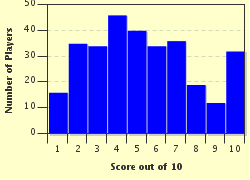Quiz Answer Key and Fun Facts
1. One of the simplest membrane proteins is the passive transporter, which binds a specific substrate and changes its conformation, allowing the substrate to be carried across the cell membrane. Which of the following is least likely to traverse the membrane via this method?
2. Active transporters are trans-membrane proteins which require extra energy to move substrate across the plasma membrane. This energy is provided either by ATP or the stored energy of a concentration gradient across the membrane. What are these two types of active transport commonly known as?
3. Enzyme-linked receptors are a second example of membrane proteins involved in cell communication, and often cause an intracellular cascade, eventually leading to enzyme activation. The cascade is often regulated by proteins which phosphorylate other molecules. What general term is used for these proteins?
4. The largest class of enzyme-linked receptors controls cell growth and cell survival. These receptors are characterised by two trans-membrane proteins brought together by a ligand to form a dimer. After which amino acid, commonly denoted by the one letter code Y, is this class of receptors named?
5. G-protein coupled receptors (GPCRs) are trans-membrane proteins and, as their name suggests, are coupled to a G-protein which is found within the cell. G-proteins, once activated, will generate diffusible, transient signals which will bring about a desired response. How are these signals commonly known?
6. Like enzyme-linked receptors, GPCRs often activate a cascade before the desired protein is activated. One such protein which is activated by the action of GPCRs is myosin light chain kinase (MLCK). Which activity does this system regulate?
7. The fastest acting type of trans-membrane receptor is the channels. Channels are characterised by a central pore, and a gate which opens according to a certain stimulus. Do ions move through channels actively (requires energy), or passively (does not require energy)?
8. Trans-membrane proteins play a vital role in the generation and propagation of nerve impulses, allowing the central nervous system to coordinate the actions of the rest of the body. Which of the following classes of trans-membrane protein is the most significant in the generation and propagation of nerve impulses?
9. As well as communicating with their surroundings, cells must also be able to communicate with neighbouring cells to which they are connected. Which of the following membrane proteins permits the exchange of ions and polar molecules between adjacent cells?
10. Neighbouring cells can be joined to one another by adherens junctions and desmosomes, which connect actin and intermediate filaments respectively. Which of the following is untrue of adherens junctions and desmosomes?
Source: Author
doublemm
This quiz was reviewed by FunTrivia editor
crisw before going online.
Any errors found in FunTrivia content are routinely corrected through our feedback system.

